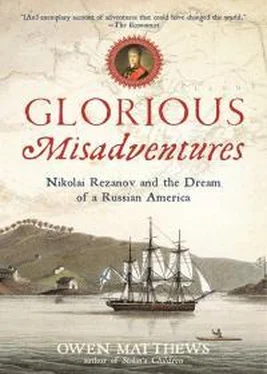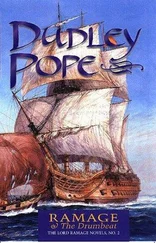11 Captain Vasily Golovnin, Memoirs of a captivity in Japan during the years 1811,12 and 13 with observations of the country and people , Henry Colburn and Co., London 1824, vol. 1, pp. 67–75.
12 Draft of letter to Count Maletsky-Yakutsky, 5 November 1806, Yudin Collection, box 2, folder 9 pp. 213–14.
13 Ivan Kalashnikov Zapiski irkutskogo zhitelya , 10 January 1807. Quoted in Black, Russians in America , p. 177.
14 Lopatnikov, ‘Nikolai Rezanov’.
15 Ibid.
16 Anna Surnik, Poslednee Pismo Kemergera: Rashifrovka in Russkaya Amerika , Vologda no. 1, Vologda 1994, pp. 29–31.
17 Ibid.
18 Rezanov to Buldakov, 25 January 1807 from Irkutsk, received at RAC 6 March 1807, ibid.
19 See memoirs of Krasnoyarsk merchant I. F. Parfentyev 1891, quoted in Avdyukov et al., Komandor .
20 Yermolaev, ‘Pskovsky Chinovnik Rezanov’ .
Epilogues
1 Lee B. Croft George Anton Schaeffer: Killing Napoleon From the Air, Sphynx Publications, 2012, pp. 14, 53.
2 Nikolay Bolkhovitinov, ‘Adventures of Doctor Schäffer in Hawaii, 1815–1819’, Hawaiian Journal of History , 1973, vol. 7, pp. 55–78.
3 Though the Tsar later relented a little and allowed trading operations.
4 Peter R. Mills, Hawaii’s Russian adventure: a new look at old history , University of Hawaii Press, 2002.
5 For the worse, it must be said.
6 See James R. Gibson, The Decembrists , Fort Ross, 2009.
7 Marc Raeff, The Decembrist Movement , Prentice-Hall, Englewood Cliffs, New Jersey 1966, pp. 19-21.
8 Frederick W. Seward. Seward at Washington as Senator and Secretary of State , vol. 3, 1891, p. 348.
9 T. Ahllund, tr. by Panu Hallamaa, ed. by Richard Pierce, ‘From the Memoirs of a Finnish Workman’, Alaska History , 21, Anchorage Fall 2006, 1–25, originally published in Finnish in Suomen Kuvalehti , no. 15/1873 – no. 19/1873.
10 19 April/1 May 1805, Löwenstern, First Russian Voyage .
11 On 22 April 1807 the astronomer on the voyage, Johann Caspar Horner (1774–1834), wrote to Krusenstern about Tilesius’ unfulfilled plans to publish his own work about the voyage, which Count Nikolai Petrovich Rumjantsev would pay for, and mentioned Löwenstern’s voluminous journal:
‘Such vermiform professors indeed remain deplorable, unreliable spirits. I am sure that if something comes [of the descriptions of the voyage], the Count will have more sea birds and dung worms than historical views. If he really intends to contribute something historical [about the voyage] or even to anticipate the publication of your voyage, then I will produce a work with woodcuts for which Lwn [Löwenstern] can give me the data, which my untroubled memory has forgotten. There is no danger in doing that since such spirits as T[ilesius] and R[ezanov] do not like each other. In addition, T produces so much all at once that nothing can come of it and he does not have endless numbers of views and pictures.’ (Ernst F. Sondermann, ‘Johann Caspar Horner über Japan’, Tohoku Gakuin Daigaku Kyoyogabu Konshu , Nr. 149, 2008, 1–26).
Löwenstern did not wish this to be published, as he makes clear in his scoffing remarks about the quill drivers on board the Nadezhda shortly before the departure from Nagasaki. (19 April 19 /1 May 1805): ‘The one, with quite a lot of talent, the least ability, and the greatest pretensions is Tilesius. Langsdorff will not be deficient in keeping himself undamaged through the voyage in every way, even if at the cost of others. Espenberg also seems inclined through the voyage to want to be brilliant in the literary world. Horner has to prove and make known to the world his observations and research in astronomy and the physical world in order to give our work validity. Romberg, who works on translations, also will not be deficient (through Karamsin) in giving the world his two bits. There are as many journals as people onboard (all the better).’
The allusion is to the famous writers of travelogues Johann Georg Forster (1759–94) and Count Marc Antoine Louis Claret de Fleurieu de Latrouette (1729–93), who described the exploration of the south Pacific.
12 Moessner, ‘The First Russian Ambassador to Japan’.
13 Instead RAC historians chose to publish Rezanov’s scheming and unbalanced letters to St Petersburg in their 1867 offical history of the company.
14 There were a few hitches on the way. Tolstoy was arrested at the gates of St Petersburg in 1805 on the orders of the Tsar and sent to serve in a distant fortress for three years before he was finally allowed back to reap the social glory in the capital. See Filipp Vigel, Zapiski , Moscow 1892.
15 Aleksei Polikovskii, Graf Bezbrezhnyi: dve zhizni grafa Fedora Ivanovicha Tolstogo-Amerikantsa , Minuvshee, Moscow, 2006.
16 Alexander Sergevich Pushkin, Eugene Onegin , tr. by Charles H. Johnston, Penguin Books Ltd, London 1977, book 6, verse 4.
17 Istomin, ‘Dva Varianta Pisma’ .
18 Löwenstern, First Russian Voyage , p. 416.
19 Ibid.
20 Ibid., p. 417.
21 Moessner, ‘The First Russian Ambassador to Japan’.
22 Löwenstern, First Russian Voyage , note 1, p. 452.
23 Ibid., note 20, p. 444.
24 Davydov, Two Voyages , p. 19 .
25 D’Wolf, Voyage to the North Pacific , p. 124.
26 Gavriil Derzhavin, Sochineniya Derzhavina s obyasnitelnymi primechaniyami Ya. Grota , Russian Academy of Sciences, St Petersburg 1866, part 3, pp. 30–36.
27 Sergei Alexandovich Kokoshkin.
28 www.ru.rodovid.org/wk/Запись:625661.
29 Iverson, Romance , p. 136.
30 Russell, Notes , p. 93.
31 According to Thomas Russell she lived with the family of Don José Antonio de la Guerra y Noriega, the ‘first family of California’ .
32 Russell, Notes , p. 95.
33 Sir George Simpson, An Overland Journey Around the World 1841–2 , Lea and Blanchard, Philadelphia 1847, p. 207.
34 Iverson, Romance , p. 89.
35 Henry Lebbeus Oak, Annals of the Spanish Northwest: California , San Francisco, 1886 (facsimile edition Kessinger Publishing, 2010), vol. 4, p. 9.
36 Like many bright New Yorkers of his generation, Harte had gone to seek his fortune in California in 1853 at the age of seventeen. He tried his hand at mining, teaching (unhindered by having left school at thirteen himself), messenger boy and finally journalist and writer. While working as assistant editor for the Northern Californian Harte began writing stories of the American frontier such as ‘The Luck of Roaring Camp’ (1868), a tale of roistering miners tamed by the responsibility of raising an orphan infant. The legend of the Wild West had been a thriving genre since James Fenimore Cooper’s Last of the Mohicans was published in 1826, but Harte quickly became a master of the Western short story.
37 Gary Scharnhorst, Bret Harte: opening the American literary West , Oklahoma University Press, Norman, Oklahoma 2000, p. 87.
38 Thanks to the popularity of Harte and Atherton, the story of Conchita and Rezanov became a part of Californian lore. ‘When we think of the love stories that have survived the ages, Alexander and Thais, Pericles and Aspasia, Antony and Cleopatra, and all the rest of them – some of them a narrative unfit to handle with tongs – shall we let this local story die?’ thundered one John F. Davis, a former judge who in retirement was the grand president of a club which grandly called itself the Native Sons of the Golden West. The occasion was a dinner on 24 November 1913 marking the placing of a commemorative bronze tablet upon the oldest adobe building in San Francisco, the former presidio , now the US Army Officers’ Club. ‘Shall not America furnish a newer and purer standard? If to such a standard Massachusetts is to contribute the Courtship of Miles Standish, may not California contribute the Courtship of Rezanov? You men of this army post have a peculiar right to unsheathe a flaming sword. For this memory of the comandante ’s daughter is yours – yours to cherish, yours to protect. In the barracks and on parade, at the dance and in the field, this “one sweet human fancy” belongs to this presidio ; and no court martial nor departmental order can ever take it from you.’
Читать дальше












